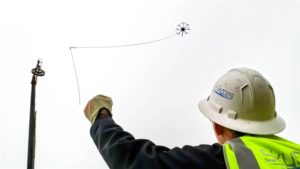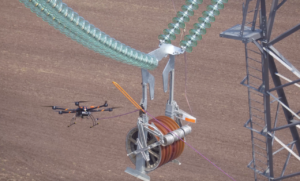Drones have been used in the power industry for a few years now, but in the U.S., power line stringing is a relatively new application. It’s an application that offers massive cost and time savings – and is one that could permanently change the way power companies work.
DRONELIFE spoke with Matt Dunlevy, President and CEO of SkySkopes, consistently named one of Frost & Sullivan’s Top 5 Drone Service Providers globally. SkySkopes was the first drone services company to perform power line stringing in the U.S., working with forward thinking energy companies like Xcel Energy and Duke Energy, among others.
SkySkopes is a premier UAS Drone Service Provider focused on bringing innovative aerial solutions to the energy sector. “We primarily use drones to fly LiDAR, Optical Gas Imaging, and EO sensors to produce actionable intelligence for utilities and oil companies,” Dunlevy says. “The organization has offices across the United States including in California, Texas, Minnesota, and North Dakota.”
Dunlevy founded SkyScopes as a spinoff of a class he was teaching at the business college at the University of North Dakota in 2014, when Dunlevy saw the potential for drone service providers in the area – even prior to Part 107, when flying legally required a Section 333 Exemption from the FAA. In 2015, SkySkopes became the first startup in North Dakota to receive permissions to fly commercially. That history has given SkySkopes the experience and the trust to work with the FAA and clients on new and innovative applications.
Power Line Stringing
Power line stringing is a relatively new application in the U.S. It’s a perfect job for a drone, however – a use that saves significant time and money, while reducing risk to workers. “This is most frequently a project completed by people physically climbing the towers, exposing themselves to dangerous heights,” explains Dunlevy, “or with helicopters manned by pilots and with serious costs incurred.”
The ROI is potentially huge. “Perhaps the biggest reduction in costs is the negated mobilization fee of a helicopter. This can be tens of thousands of dollars that the utility would save per project simply by switching to drones,” says Dunlevy. “It also increases safety factors, which are priceless.”

Image Provided by SkySkopes
Dunlevy says that one of the largest investor owned utilities in the United States saw the potential in using drones. “They were interested in reducing their risk exposure when hanging the lead lines on transmission towers,” Dunlevy explains. “They called us based on our reputation for aviation safety in addition to our highly certified and experienced pilots.”
The Process
It was a concept that the utility company was anxious to prove – and they were willing to work with a drone services provider to figure out the best operational process.
Dunlevy explained the mission: “We use multiple UAS to carry a lead line onto a pulley system’s guide rail, and trip the spring loaded “gate” by exerting force created by the drone’s both directed thrust and lift characteristics,” he says. “When the line is maneuvered to the middle of the pulley, a pilot drops the end not suspended in the air using some of our proprietary technology.
“The line can then pull a conductor wire through and voila – a powerline is closer to being energized,” says Dunlevy. “These lines were some of the most massive in the country: and at 765 kV, they proved that the mission can be done with UAS on any type of power line.”
While the application was a success, it’s still relatively new: and Dunlevy says that greater adoption will require education of the industry. “Right now 99% of these types of operations are being done with traditional methods,” Dunlevy says. “Many potential adopters are unaware of the new methodology, cost savings, and time savings.”
The process is less expensive and faster than traditional methods – but it still requires skilled pilots. “None of this is automated,” says Dunlevy. “It would be too monumental a task to add AI into the flight profile, especially considering that such sensors increase the weight on an already heavy airframe needed to hoist rope as it unravels from a spool at the launch site.
“The flight first takes place at the base of the structure, and then, depending on battery power and endurance, the aircraft will ferry the line in the air to the next tower in the corridor. After the aircraft detaches the line, it lands: we replace batteries, rinse, and repeat.”
Evolving – and Improving
As all aspects of the drone industry evolve, the power line stringing applications has gotten better since SkySkopes first started performing the mission. “Different aircraft, different flight methodologies, different supporting command vehicles, different associated and tertiary equipment, different types of rope, different clients, and different regulatory environments.. every change in the methodologies represent an improvement that allows us to serve our clients better,” he says. As the first service provider to execute power line stringing in the U.S., SkySkopes’ pilots have also brought their skills to bear to the problem. “It has been interesting to see the creativity of our pilots come into play, with the new payloads and slack compensators,” says Dunlevy.
Challenges
All of the factors that influence a drone mission are potential challenges in stringing power lines. “Weather, terrain, daylight, climate, and other factors affecting UAS missions in general are magnified when stringing lines,” says Dunlevy. “Sometimes the line itself, a pseudo-tether, can act as a safety measure in case a UAS would want to fly away… We’ve never had to use it this way, but we see it that way.
“Other challenges include the types of pulleys and height of towers.”
As more companies learn about the potential for power line stringing – and execute their own pilot programs to implement the application across their operations – drones could change the way that power line stringing is done around the world. It’s an application with benefits for all stakeholders: power line workers, power companies and their customers, and the drone industry.
Miriam McNabb is the Editor-in-Chief of DRONELIFE and CEO of JobForDrones, a professional drone services marketplace, and a fascinated observer of the emerging drone industry and the regulatory environment for drones. Miriam has a degree from the University of Chicago and over 20 years of experience in high tech sales and marketing for new technologies.
For drone industry consulting or writing, Email Miriam or (for paid consulting engagements only) request a meeting through AdvisoryCloud:
TWITTER:@spaldingbarker
Subscribe to DroneLife here.
https://dronelife.com/2020/03/19/dronelife-exclusive-how-drones-will-change-power-line-stringing-forever/
 Unmanned Aerial Vehicle The latest drone news
Unmanned Aerial Vehicle The latest drone news






